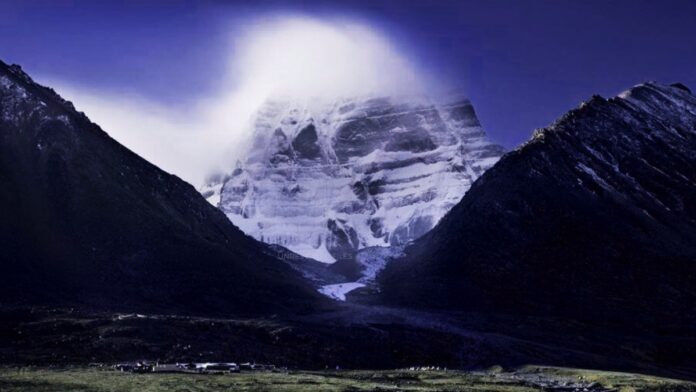Mount Kailash better known as Kailash Parvat, located in the remote western region of Tibet, is a mountain steeped in mystery and spirituality. Standing tall at 6,638 meters (21,778 feet), this majestic peak has been revered as one of the holiest mountains in the world. Its geographical and geological significance, along with its religious importance to Hinduism, Buddhism, and Jainism, have made it a sought-after pilgrimage site. Moreover, Mount Kailash is enshrouded in various mysteries and legends, including its unclimbed summit, the presence of a swastika-shaped formation, and the mystical Lake Manasarovar. In this article, we will Unveil the Mysteries of Kailash Parvat and delve deeper into the wonders and mysteries surrounding Mount Kailash.
Contents
Geographical and Geological Significance
Situated in the remote region of western Tibet, Mount Kailash boasts awe-inspiring physical characteristics. Its distinct shape and elevation make it a striking presence in the surrounding landscape. Additionally, the mountain is surrounded by other sacred peaks and lakes, creating a mystical and serene environment. From a geological standpoint, Mount Kailash was formed as a result of tectonic plate movements, and its rock formations and glacial features are unique and fascinating. The study of this mountain provides valuable insights into the formation of the Himalayas and the region’s geological history.
Religious Significance
Mount Kailash holds immense religious significance for multiple faiths. In Hinduism, it is believed to be the abode of Lord Shiva, and circumambulating the mountain is considered a sacred act. Hindu pilgrims from India and Nepal undertake the arduous journey to fulfill their spiritual obligations. Similarly, in Buddhism, Mount Kailash is associated with Buddha Demchok (Cakrasamvara) and holds great importance in Tibetan Buddhist cosmology. Tibetan Buddhists also engage in the practice of circumambulation around the mountain as a part of their spiritual journey. Jainism recognizes Mount Kailash as a sacred site associated with Rishabhadeva, the first Tirthankara. Jain rituals and ceremonies are performed at the mountain, showcasing its significance in Jain spiritual practices.
Scientific Exploration and Preservation
Recently, there has been an increased focus on scientific exploration and preservation efforts concerning Mount Kailash. Environmental protection plays a vital role in safeguarding the fragile ecosystem of the mountain. Conservation efforts have been implemented, and restrictions on human activities have been imposed to maintain the sanctity of the area. Balancing tourism with preservation has become a key challenge. Moreover, geological studies have shed light on the unique rock formations and glacial features of Mount Kailash, providing insights into the geological processes and ancient history of the region. Continued scientific exploration is crucial for further unraveling the mysteries and preserving the natural wonders of this sacred mountain.
Unsolved Mysteries of Kailash Parvat
Mysteries and Legends
Mount Kailash is not only known for its religious significance but also for the mysteries and legends that surround it. The most intriguing aspect is its unclimbed summit. Despite numerous attempts, the treacherous nature of the mountain has prevented successful ascents. The spiritual beliefs and reverence surrounding Mount Kailash contribute to the lack of climbing attempts, rendering it unconquered and enhancing its aura of mystique. Another mystery lies in the presence of a giant swastika-shaped formation on the southwestern face of the mountain. The origin and symbolism of this symbol have sparked various theories and interpretations, stirring debates and discussions. Furthermore, the mystical Lake Manasarovar near Mount Kailash is enveloped in legends. Its sacred significance, mythical origins, and rumors of hidden treasures lurking in its depths add to the fascination surrounding this pristine lake.
Geographical Location
Mount Kailash better known as Kailash Parvat is a stunning mountain located in the southwest corner of the Himalayan Mountains of Tibet. It is one of the highest regions of the Himalayas, at 6638 m (21778 ft) high, it is also the source of some of the longest rivers in Asia. Mount Kailash, or Gang Tis or Gang Rinpoche in Tibet, is a valuable and remarkable symmetrical peak. Mount Kailash made of black rock is a magnificent diamond-shaped peak surrounded by a gorgeous, rocky, and arid landscape. Thousands of years have passed since followers of all faiths visited Kailash and circumambulated the holy mountain on foot. It is thought that visiting Kailash and adhering to this custom will bring good luck and wash away one’s sins. According to Hindu mythology, Shiva, the deity of destruction and rebirth, is said to live at the summit of Kailasa. Tibetan Buddhists believe that Kailash is where the Buddha Demchok, who represents absolute harmony, resides. They also claim that Buddhism replaced Bön as Tibet’s dominant religion at this hallowed peak. According to legend, Milarepa, the Tantric Buddhist winner, traveled to Tibet to fight Naro-Bonchung, the Bön spokesman.
Regular Change In Position
Nobody has been able to ascend the summit save a Tibetan Buddhist monk named Milarepa in the 11th century since it varies its destination and tends to obstruct the paths, leading climbers astray. Many trekkers have never returned because they abruptly changed directions or were forced to descend due to severe weather conditions.
Kailash Parvat In Different Religions
Mount Kailash is considered one of the holiest mountains in the world. It has become a significant pilgrimage site for four religions. Buddhists, Jains, Hindus, and Tibetans follow the Bon faith. Thousands of pilgrims from all around the world visit this site every year. Mount Kailash is honored by Hindus, Buddhists, Jains, and Bon religions as a Sanctum Sanctorum. Hindus revere Kailash as Shiva’s dwelling. Mount Kailash’s four faces Mount Kailash has four unique faces: north, west, south, and east. Mount Kailash, according to the Puranas, is located in the center of the Earth and is responsible for splitting it into four sections based on various quarters. Mount Kailasa is regarded as heaven, the final destination of souls, and the religious center of the earth by many Hindu groups. Mount Kailash’s four sides are formed of crystal, ruby, gold, and lapis lazuli, according to the Puranas. The world’s tallest pillar, at 84,000 leagues, is known as the pillar of the globe. Four rivers flow from it, reaching the four corners of the globe and dividing the world into four sections.
Stairway Between Heaven And Earth
According to the Vedas, Mount Kailash is a ladder between heaven and earth. According to the Mahabharata, the Pandavas, along with their only wife Draupadi, climbed Mount Kailash to attain salvation. Yudhishthira saves everyone one by one while climbing the rock on his way to heaven. It is said about Yudhishthira that he was the only one who was able to enter heaven. Mount Kailash is the culmination of perfection as its four slopes represent the four directions of the compass. The disciples are sure that this is the gateway to heaven.
Conclusion
Mount Kailash remains an unparalleled destination that captivates the hearts and minds of people from various walks of life. Its blend of geographical, geological, and religious significance makes it a truly remarkable site. The unclimbed summit of Mount Kailash stands as a testament to the spiritual reverence it commands, while the presence of the swastika-shaped formation adds an air of intrigue and symbolism. The mystical Lake Manasarovar, with its legendary origins and rumored hidden treasures, adds to the allure of this sacred place.
As we continue to explore the wonders of Mount Kailash, it is crucial to prioritize its preservation and environmental protection. Efforts must be made to strike a balance between tourism and conservation, ensuring that the fragile ecosystem of the mountain is safeguarded for generations to come. With ongoing scientific studies, we can gain further insights into the geological history of the region and unravel the mysteries that surround Mount Kailash.
Whether it be the arduous pilgrimage undertaken by Hindu, Buddhist, or Jain devotees, or the curiosity that draws adventurers and researchers to its slopes, Mount Kailash holds an undeniable power to inspire and intrigue. It is a testament to the human desire for spiritual connection and exploration of the unknown.
In conclusion, Mount Kailash is not merely a mountain; it is a sacred symbol, an enigma, and a place of profound significance. Its geological formation, religious importance, and enduring Kailash Parvat mystery continue to captivate our imagination. Whether gazing upon its majestic peak, undertaking a circumambulation, or delving into its legends, Mount Kailash offers a unique and awe-inspiring experience that lingers long after the journey is complete. It is a testament to the rich tapestry of human beliefs, spirituality, and our eternal quest for meaning in the world. Read more mysteries.
Also Read: The Kalinga War: A Turning Point in Ancient Indian History
Sources
- Bhardwaj, S. M. (1983). Hindu Places of Pilgrimage in India: A Study in Cultural Geography. Univ of California Press.
- The Holy Mountain Being The Story Of A Pilgrimage To Lake Manas And Of Initiation On Mount Kailas In Tibet : Bhagwan Shri Hamsa, Internet Archive.
- Dowman, K. (1988). The Power-Places of Central Tibet: The Pilgrim’s Guide. Routledge.
- Guo, S., & Pu, J. (2014). Geological Research on Kailash Area in the West of Tibet. Acta Geologica Sinica (English Edition), 88(4), 1163-1178.
- Rawat, M. S. (2015). Sacred Peaks of Western Himalayas. Indus Publishing Company.
- Thubron, C. (2011). To a Mountain in Tibet. Harper Perennial.
- Van Schaik, S. (2011). Tibet: A History. Yale University Press.
- Wilkinson, J. C. (1999). The Swastika: A Symbol in Transition. Routledge.
- Wu, Y., Zhang, Y., & Cui, L. (2015). Holocene Glacial Fluctuations and Weathering of Mount Kailash in Southwestern Tibetan Plateau. Geografiska Annaler: Series A, Physical Geography, 97(4), 625-641.
- www.sacred-destinations.com/tibet/mount-Kailash (Sacred Destinations: Mount Kailash)
- www.britannica.com/place/Mount-Kailas (Encyclopedia Britannica: Mount Kailas)
- www.tibettravel.org/kailash-tour (Tibet Travel: Mount Kailash)
FACT CHECK: We strive for accuracy and fairness. But if you see something that doesn’t look right, please Contact us.
DISCLOSURE: This Article may contain affiliate links and Sponsored ads, to know more please read our Privacy Policy.
Stay Updated: Follow our WhatsApp Channel and Telegram Channel.














